Buildings, bridges, tunnels and dams require effective maintenance to keep them working safely, so engineers fit instruments to measure stress and strain, temperature and vibration. In the past decade, several companies have pioneered fibre optic sensors based on laser and optical telecommunications technology.
Fibre optics have important technical advantages over traditional instruments, such as immunity to electromagnetic interference and chemical damage, and ability to transmit multiplexed data over large distances. By embedding optical fibre sensors into the structure of a bridge during construction, engineers can check the bridge’s behaviour throughout its lifetime, collecting at a central monitoring station a large number of continuous measurements. Fibre-based sensors do not drift over time, so recalibration is unnecessary.
Fibre Bragg gratings
Fibre optic sensors use a variety of techniques – from low-coherence interferometry to optical time domain reflectometry, Brillouin scattering, Fabry-Perot interferometry and fibre Bragg gratings (FBGs). The FBG has narrowly spaced lines of varying refractive indices over a region of core about 1 cm long. This reflects light at a particular wavelength from a broadband source. The wavelength depends upon the line spacing, which changes with the movements of the monitored structure. An FBG sensor measures the strain at a particular point, but a single fibre can incorporate hundreds of FBGs, and one interrogator instrument measures all the reflections. This makes for a very simple but powerful setup that checks many different points of the structure simultaneously. Temperature also affects the wavelength reflected by the FBG, so the sensors are often paired, with one isolated from the structure’s movement, allowing independent measurement of strain and temperature.
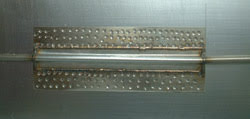
SmartWeld is a fibre optic strain sensor for harsh environmental conditions that spot-welds to steel structures such as ships’ hulls. Picture courtesy of Smart Fibres Ltd.
In the 1990s, Smart Fibres Ltd. was founded in Bracknell, UK, to develop FBG-based sensor systems, and the company introduced its first commercial instrument in 2000. It packages the sensors in different ways for easy installation in various situations. For example, its SmartWeld strain sensor spot-welds onto the steel structures of bridges, buildings and cranes, and SmartBars are designed for encasement in concrete.
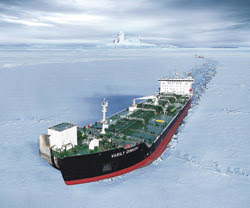
Smart Fibres Ltd. is supplying a fibre Bragg grating system to monitor ice pressure on the hull of the Arctic shuttle tanker Vasily Dinkov, built by Samsung Heavy Industries in Seoul, South Korea. Picture courtesy of Samsung Heavy Industries Co. Ltd.
Smart Fibres is working with the South Korean company Global Maritime Engineering to monitor ice pressure and load on the hulls of Arctic shuttle tankers. This is a new class of ship that operates in polar waters, transporting huge quantities of oil from Russian offshore fields and breaking the ice as it progresses. It copes with temperatures down to –40 °C and with ice up to 1.5 m thick. The project uses SmartWeld strain and temperature sensors, FBG acceleration sensors and high-speed W5 instrumentation, which interrogates 250 sensors simultaneously at a scan frequency of up to 1 kHz.
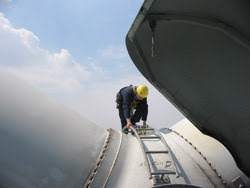
Feedback from fibre optic sensors enables planned servicing and emergency response for wind turbines. Picture courtesy of Smart Fibres Ltd.
Smart Fibres also is active in the energy and aerospace sectors. Wind turbines are often in wild locations far from human habitation, so real-time condition monitoring is important for planned maintenance, particularly on offshore wind turbines, where access can be limited for long periods of time. The company also has developed a system for monitoring the loads on the rotor blades, by using either bare FBG sensors embedded within the composite layers during construction or SmartPatch sensors that can be surface-mounted to the internal surface of the blade, even after deployment.
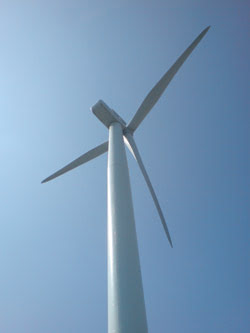
SmartPatch fibre Bragg grating sensors provide real-time condition monitoring and pitch control of the rotor blades of remotely sited wind turbines. Picture courtesy of Smart Fibres Ltd.
Smart Fibres has developed new interrogators that make the cost commercially viable. The turbine operator can even use the measurements for real-time adjustment of blade pitch for increasing output and improving balance. This system is undergoing long-term tests on a Dutch turbine. An oil well in the Middle East is using a distributed pressure sensing system to keep a long-term check on reservoir conditions and thus optimize oil production. As part of the European collaborative project AHMOS (active health monitoring of structures), Smart Fibres has demonstrated the flightworthiness of its aircraft structural monitoring system in a BAE Systems Hawk jet.
Raman effects
A different technique for monitoring temperature at multiple points is to measure the intensity of backscattered laser pulses in an unmodified telecomms fibre. The interrogator sorts out Rayleigh, Raman and Brillouin scattering and measures the pulse reflection time. The Raman component comes from temperature-dependent molecular vibrations, so an analysis of wavelength and timing detects temperature anomalies along the fibre and calculates their exact location.
More than 20 years ago, Sensa began to commercialize the fibre optic sensing technology originating at Southampton University in the UK. Its distributed temperature sensing (DTS) technology detects changes of 1 °C or less as soon as they happen and finds the location of each temperature event with 1-m accuracy in a fibre up to 30 km long. One emerging application is pipeline monitoring in liquefied natural gas plants. The system quickly detects and locates leaks, enabling rapid repair. It also monitors the flushing procedure that cools the pipes before liquefied natural gas transport. Other applications are fire alarm systems in road and rail tunnels, temperature measurement in oil refineries and petrochemical plants, power generation and distribution systems. Sensa also supplies DTS modelling software for visualization of temperature measurements, and its Data2View package colour-maps temperature zones to assist in process monitoring and fire detection.
Sensornet Ltd. of London makes Sentinel DTS sensors with resolution better than 0.01 °C. These come with ranges from 5 to 10 km, while the DTS-XR system with a 30-km extreme range has a temperature resolution of less than 0.05 °C. The company has successfully tested the DTS-XR in detecting overheated regions in overhead electrical power lines. It recorded the small temperature decrease as the power line runs over each pylon and the temperature increase caused by reduced heat dissipation in woodland areas.
Sensornet also used its distributed temperature and strain sensor to measure cable sag and to ensure that the power line is within safe strain limits. The technology analyses the full Brillouin spectrum to make independent measurements of temperature and strain. A lab trial showed that it can detect the yield point of steel under compression and identify the points of maximum strain. This has applications in long-range monitoring of structural elements.
Low-coherence interferometry
Smartec SA of Manno, Switzerland, has developed the SOFO technique of measuring elongation in bridges and tall buildings. A plastic pipe contains a pair of single-mode fibres. One stretches between structural contact points so that it moves with the building, and the other lies untethered beside it to cancel out temperature effects. Infrared light passes through both fibres and reflects from mirrors at the end. The analyser uses a moving mirror to measure the change in path length caused by movements of the structure.
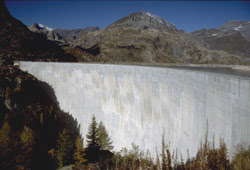
SOFO sensors monitor the integrity of dams, continuously measuring strain and absolute displacement, curvature and shape deformation. Picture courtesy of Smartec SA.
Engineers have used SOFO to check for cracks in the clay core of the 156-m-tall Canales Dam in Grenada, Spain. They drilled a borehole 110 m into the clay and anchored the sensors within it. In the Ke-Ya Bridge in Taiwan, SOFO sensors incorporated before concrete pouring monitored deformation during the prestressing process. Smartec now is part of the RocTest Group. Roctest Ltd. of St. Lambert, Quebec, Canada, markets a fibre optic sensor system to detect stresses on bridges, and this technology was used in the rebuilding of the I-35W St. Anthony Falls Bridge in Minneapolis, which reopened on 18 Sept., 2008, approximately a year after its collapse on 1 Aug., 2007.